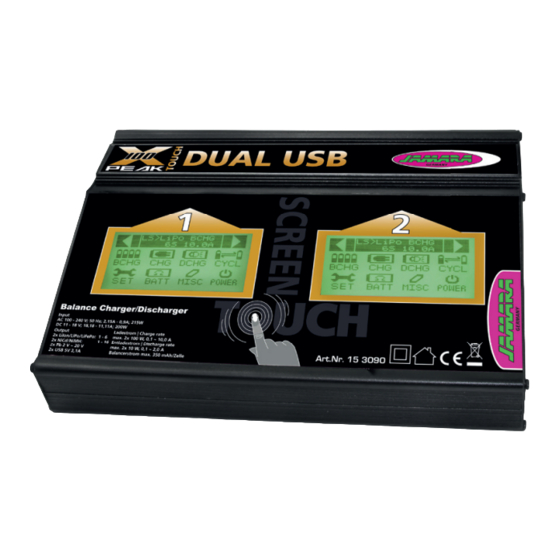Jamara 15 3090 Instruction - Page 6
Parcourez en ligne ou téléchargez le pdf Instruction pour {nom_de_la_catégorie} Jamara 15 3090. Jamara 15 3090 8 pages.

Los mensajes de error
El cargador está preparado con una serie de mensajes de error. Todos los mensajes de error se
muestran en la pantalla y van a interrumper inmediatamente el proceso para protegir el cargador
y la batería de dañaos.
1
1.
La batería se ha conectada con la polaridad inversa.
2.
El circuito de carga tiene una ruptura.
3.
Corto circuito en la voltaje de salida.
4.
El voltaje de entrada está fuera de los límites permitidos(1 - 18 V).
5
5.
Dispositivo de error desconocido inmediatamente desconectar de la fuente de alimentación.
6.
La tensión de una batería de litio es demasiado alta.
7.
La tensión de una batería de litio es demasiado baja.
8.
Una celda de una batería de litio tiene un nivel de tensión insufi ciente.
9
9.
Una celda de una batería de litio tiene un nivel de voltaje demasiado alto.
10. Mal, conexión de alta resistencia en el circuito de carga.
11. El cargador está demasiado caliente, dejar enfriar.
12. El cargador ha superado la potencia de salida.
6
DE - Externe Funktionsprogramme
1.
Wählen Sie zwischen USB und
Servotester
2.
USB Monitor
3.
Servotester
Menú Digital Power
El cargador se puede utilizar como fuente de alimentación para dispo-
sitivos eletrónicos con una tensión de salida de 3,0 V – 24 V.
1. Ajuste los valores individuales de tensión, corriente, vatio máximo
y duración.
2. Procesamiento Digital.
2
6
10
GB - Extern function program
1.o
Can select USB Monitor /
Servotester
2.
USB Monitor
3.
Servo Tester
GB - Digital power program
In this mode, charger can provide a output power of DC 3,0 V - 24 V
for the other electronic equipment.
1. Set voltage / current / watt / run time
2. Digital power working.
Warning and orror information
The Charger is protected agains faults and operator errors by the Multi-Protections-System. Faults/
Errors are displayed on the LCD screen and they interrup the active process to protect the unit and
the battery.
3
1.
The output ist connected to a battery with incorrect polarity.
2.
Not connected or connection interruption.
3.
Output short circuits.
4.
Input voltage error, below or over the limit of 10 - 18 V.
7
5.
Charger fault.
6.
Total voltage too low.
7.
Total voltage too high.
8.
Unit cell voltage too low.
11
9.
Unit cell votage too high
10. Balance port connection error.
11. Charge overheating
12. Power exceed the limit in the digital power mode.
4
8
12
